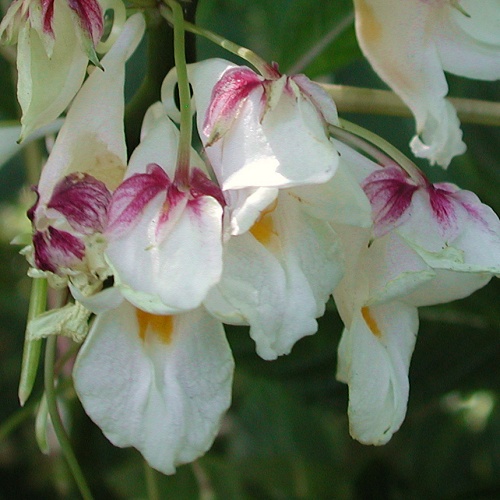| Home |
Strange Wonderful Things
Rare and exotic plants
|
 |
Impatiens roingensis

Germinating the seeds
When to plant -- Plant your seeds when you receive them for best germination.
Getting started -- You may plant each seed in individual, small containers. Or you plant them all in a single
container, but it may be difficult to transplant them later. Either way, use pots with drainage holes
For soil, use a well draining mix
that's high in organic matter. A typical mix is 2 parts potting soil to 1 part perlite or
coarse sand. An alternate mix is 1 part perlite to 1 part coir fiber, with some slow-release fertilizer added.
Fill the pots with soil, and place a seed or 2 on the surface.
Sprinkle a very thin layer of soil (1/16th of an inch, or 2 milimeters). Light helps the seeds germinate, so they should not be buried completely.
Add water until the soil is uniformly moist (but not saturated).
Until the seeds sprout, ensure that the surface soil always stays moist. A plastic dome or bag may be used to
maintain moisture, but leave it open a crack to allow some fresh air in. You may need to drip a few drops of water over the seeds
each day to keep the seeds
moist.
The ideal temperature for germination is between
about 65 to 77 degrees F (18-25°C). A little cooler at night is ok.
Avoid letting them get above 80° F (27°C). I recommend placing a minimum/maximum thermometer near the pots.
The seeds need some light to germinate. A fluorescent
or LED bulb kept 4 inches (10 cm) away provides the right amount of
light. Protect from direct sun.
They should begin germinating in 3 to 5 weeks, and continue for another 6
weeks. For the first 2-3 weeks after sprouting, continue keeping the
soil surface moist.
Growing onward...
Lighting -- This Impatiens prefers bright shade, or filtered sunlight. Avoid prolonged direct sun, unless it's early-morning sun.
Transplanting -- When your plants are 2-3 months old, you may gently transfer them to a larger pot. Water the soil first, and avoid letting the soil ball break
apart, which can damage the roots. After transplanting, avoid packing the soil down, and don't fertilize the first week.
Watering -- Aim to keep the soil moist, but not soggy, most of the time. You may use a moisture meter probe to monitor the moisture levels down in the root zone.
Climate -- This Impatiens prefers mild temperatures. In warmer areas, give it plenty of shade and moisture. Protect from freezing temperatures. Above about
40% humidity is best. Indoors, if the humidity is too low, consider using an ultrasonic room humidifier, which you can buy at places like Home Depot and thrift shops.
Fertilizing -- A liquid fertilizer is best the first month. Feed a
very light dose (1/8th strength) of liquid fertilizer weekly. After a
month you may switch to a granular, general-purpose fertilizer, feeding about
every 2 months. Follow the dosage on the package.
It's normal for a leaf to occasionally turn yellow and drop, but if it seems excessive, the plant may need more fertilizer,
particularly nitrogen. Also check that the soil isn't too dry down in the root zone.
Pests to watch for -- aphids, scale (dark disks on the stems), mealy bugs. Be careful when choosing chemical remedies, because some may harm the plant.
Contact me if you have questions.
Have fun growing them!
- Jeff
Strange Wonderful Things
| Home |
Strange Wonderful Things
Rare and exotic plants |

|
| Entire site Copyright 2003-2023 by Strange Wonderful Things, except as noted |
|


